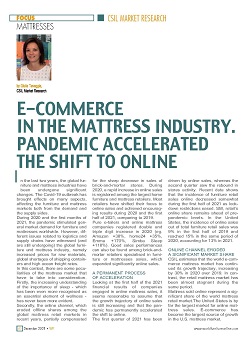E-commerce in the mattress industry. Pandemic accelerated the shift to online


In the last two years, the global furniture and mattress industries have been undergone significant changes. The Covid-19 outbreak has brought effects on many aspects, affecting the furniture and mattress markets both from the demand and the supply sides.
During 2020 and the first months of 2021, the pandemic stimulated general market demand for furniture and mattresses worldwide. However, different issues related to logistics and supply chains have witnessed (and are still undergoing) the global furniture and mattress industry, namely increased prices for raw materials, global shortages of shipping containers and high ocean freight rates.
In this context, there are some peculiarities of the mattress market that must take into consideration. Firstly, the increasing understanding of the importance of sleep – which has been even more recognised as an essential element of wellness – has never been more evident. Secondly, the online channel, which eroded offline shares among the global mattress retail markets in recent years, partially compensated for the sharp decrease in sales of brick-and-mortar stores.
During 2020, a rapid increase in online sales is registered among the largest home furniture and mattress retailers. Most retailers have shifted their focus to online sales and achieved encouraging results during 2020 and the first half of 2021, compared to 2019. Pure e-tailers and online mattress companies registered double, and triple-digit increase in 2020 (eg. Amazon +38%, home24 +35%, Emma +170%, Simba Sleep +118%). Good sales performances can also be found among brick-and-mortar retailers specialised in furniture or mattresses sales, which expanded significantly online sales.
A PERMANENT PROCESS OF ACCELERATION
Looking at the first half of the 2021 financial results of companies engaged in online mattress sales, it seems reasonable to assume that the growth trajectory of online sales is still increasing and that the pandemic has permanently accelerated the shift to online. The first quarter of 2021 has been driven by online sales, whereas the second quarter saw a rebound in stores activity.
Recent data shows that the incidence of furniture retail sales online decreased somewhat during the first half of 2021 as lockdown restrictions eased. Still, retail’s online share remains ahead of pre-pandemic levels. In the United States, the incidence of online sales out of total furniture retail sales was 9% in the first half of 2019 and reached 15% in the same period of 2020, accounting for 13% in 2021.
ONLINE CHANNEL ERODED A SIGNIFICANT MARKET SHARE
CSIL estimates that the world e-commerce mattress market has continued its growth trajectory, increasing by 30% in 2020 over 2019. In contrast, the retail mattress market has been almost stagnant during the same period. Mattress sold online represent a significant share of the world mattress retail market.
The United States is by far the largest market for online mattress sales. E-commerce has become the largest source of growth in the U.S. mattress market.
In Europe, small markets as Spain, Portugal, the Netherlands registered the highest growth rates in online mattress sales for 2020. However, traditional markets as Germany and the United Kingdom have continued to grow at extraordinary rates (double- digit growth).
Asia Pacific is among the fast-growing and promising area for online mattress sales, registering an increase of nearly 30% in 2020 over 2019. China leads the e-commerce mattress market. With a high e-commerce penetration, South Korea is the second-largest market for online mattress sales across the region.
According to the CSIL’s survey launched in September and closed in October 2021, when looking at promising markets for e-commerce sales of mattresses, the United States and India registered the highest scores. As far as Europe, the United Kingdom and Germany are the most mentioned market with the highest scores.
MULTICHANNEL WILL REMAIN IMPORTANT
The shift to online sales has been significant during 2020, sustained by stores’ closure and restrictions. However, the trend towards a multichannel approach remains important.
Even more online mattress companies expanded their wholesale channel (brick-and-mortar retail partners), offering their products across physical stores and online, or opening owned showrooms or pop-up stores (expanding their D2C channel).
Even if the shift to the online channel is significant across traditional and emerging markets, the physical presence remains important for mattress sales. It is reasonable to estimate that the incidence of online sales will decrease in 2021 and, particularly, in 2022.
Available CSIL Reports on the Mattress Sector:
- E-Commerce in the Mattress Industry, edition October 2021.
- The World Mattress Industry, edition July 2021